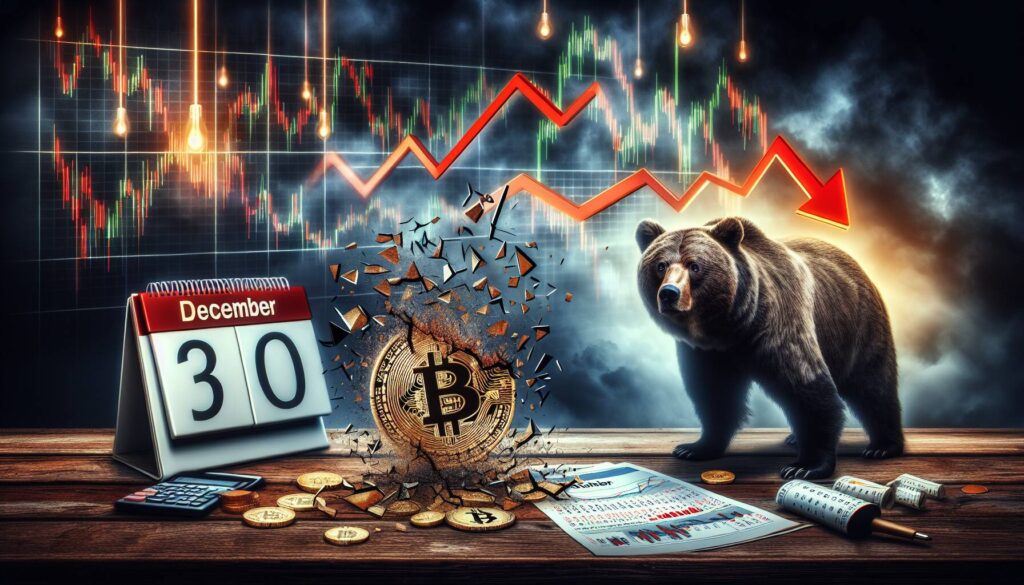The cryptocurrency landscape is witnessing a renewed discussion on the roles of traditional assets versus digital currencies, particularly in light of the Trump administration’s outspoken support for cryptocurrencies. Investors are now tasked with understanding whether gold’s longstanding status as a safe haven could be challenged by the rise of bitcoin.
André Dragosch, the European head of research at Bitwise Asset Management, recently shared insights that illuminate this shifting dynamic. His analysis establishes that while gold has historically been favored during periods of stock market turmoil, bitcoin’s relationship with bond markets is becoming increasingly significant.
“Gold remains the preferred protection against equity market losses, while bitcoin may serve as a stabilizing force amidst bond market pressures,” Dragosch remarked in a post.
Historically, gold has been the go-to asset when stocks take a hit, demonstrated by its price increases during stock downturns, such as in the 2022 bear market. As the S&P 500 declined, gold managed to rise approximately 5%, reinforcing its reputation as a classic safe haven.
Conversely, bitcoin has not fared as well during equity market sell-offs, often experiencing significant downturns alongside tech stocks. However, its behavior in relation to U.S. Treasuries has provided a more complex picture, with studies showing it sometimes holds up better than gold amid rising bond yields and fiscal concerns.
As of August 31, the diverging performances of these assets underlines Dragosch’s observations: gold is seeing a resurgence, up over 30% year-to-date, while bitcoin has shown a commendable gain of about 16.46%. Such trends suggest that while gold serves effectively during stock market jitters, bitcoin establishes itself during volatility in bond markets.
“The key takeaway is not to choose between gold and bitcoin but to understand their unique roles in a diversified portfolio,” Dragosch concludes, citing research that supports both assets as vital tools for managing different types of financial risk.
Nonetheless, correlations between these assets are subject to change, particularly as bitcoin becomes more integrated with traditional investment trends through significant inflows into spot ETFs. This evolving landscape invites investors to consider both the short-term shocks and long-term correlations that might affect their strategies.

Gold vs. Bitcoin: Understanding Their Roles in Investment Portfolios
Key aspects to consider regarding gold and Bitcoin in today’s economic landscape:
- Historical Performance of Gold
- Gold typically acts as a safe haven during stock market downturns.
- During significant market stress, such as the 2022 bear market, gold prices can increase while equities fall.
- Bitcoin’s Counterweight Role
- Bitcoin often struggles during equity sell-offs but can perform better against bond market pressures.
- Low or negative correlation with government bonds suggests Bitcoin may help during fiscal uncertainties.
- Complementary Roles in Portfolios
- Gold serves best when stocks are volatile, while Bitcoin may stabilize portfolios amid rising bond yields.
- Investors are encouraged to hold both assets for diversified risk management.
- Recent Market Trends
- As of 2025, gold has outperformed Bitcoin amid equity volatility, confirming its status as a safe haven.
- Bitcoin has shown resilience against concerns of rising U.S. Treasury yields.
- Caveats and Market Dynamics
- Correlations between Bitcoin and equities may change with market conditions and regulatory developments.
- Short-term macroeconomic shocks can impact both assets simultaneously, influencing their hedging effectiveness.
Recognizing the distinct roles of gold and Bitcoin can enhance investment strategies and optimize risk-adjusted returns.
Gold vs. Bitcoin: The Evolving Role of Hedge Assets in 2025
As the crypto landscape continues to develop under the influence of market trends and regulatory shifts, the debate between traditional assets like gold and newer entrants like bitcoin intensifies. André Dragosch, a key figure in research at Bitwise Asset Management, highlights how these two assets serve distinct purposes in investment portfolios, which can be a crucial factor for investors looking for stability amidst market volatility.
Competitive Advantages: Gold remains the cornerstone for investors seeking a reliable hedge against stocks. Historical performance showcases gold’s ability to thrive during stock market downturns, making it a timeless “safe haven.” Its negative correlation with the S&P 500 in times of stress underpins this advantage, offering solace when equities falter. Conversely, bitcoin emerges as an intriguing asset during challenges in the bond market; its recent behavior suggests it might hold its ground when government bonds face pressure from rising yields and fiscal concerns. This dual role creates a compelling case for including both in a diversified portfolio.
Competitive Disadvantages: However, the very nature of these two assets brings inherent risks. Bitcoin’s sensitivity to stock market dynamics raises questions about its reliability as a hedge. The surge of institutional interest, especially through spot ETFs, has tied bitcoin more closely to mainstream market fluctuations, diluting its hedging capabilities against bonds. On the other hand, while gold is steadfast in stock market crises, it may not react as favorably in times of economic recovery or bullish bond conditions, potentially limiting its upside for certain investors.
Beneficiaries and Challenges: Investors seeking to navigate the complexities of today’s financial landscape can find benefit in understanding these distinct roles. Tactical asset allocators may utilize both gold and bitcoin to optimize risk-adjusted returns, leveraging gold’s protective qualities during stock downturns and bitcoin’s resilience amid bond stress. However, investors must remain vigilant; sudden changes in the macroeconomic environment or regulatory landscape could disrupt these correlations, leading potentially to unintended consequences for those heavily invested in either asset alone. Consequently, the risk comes not just from market movements but from the shifts in investor sentiment propelled by external factors.

















